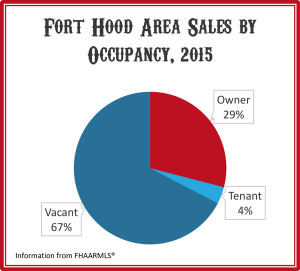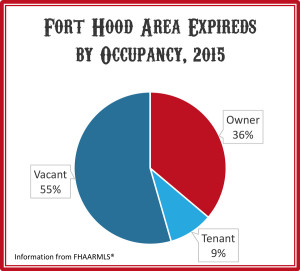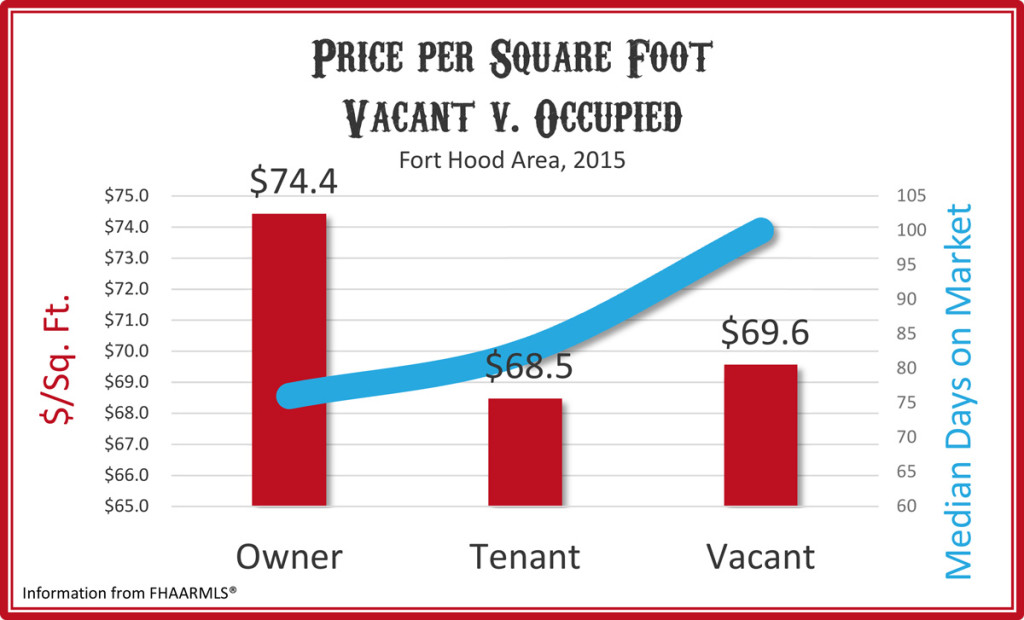Takeaways
- Owner Occupied home owners are likely NOT “motivated sellers”.
- 2/3 homes for sale on the Fort Hood area market are vacant.
- Selling your home while it still has a tenant is the least desirable situation for a seller.
 Selling a vacant home is best, right?
Selling a vacant home is best, right?
“Obviously, selling vacant is ideal,” I always tell my sellers. I think most agents do. Most homes sold in the Fort Hood area are vacant (about 2/3ds). Working with buyers, it is FAR easier to schedule and view vacant homes than coordinating showings with the listing agent and seller (or tenant). Alarms, dogs, and messy homes are no fun. So, I tell my sellers that, if possible, it is best to have moved out of the home and sell vacant.
But I wondered, what does the sales data say? Do owner occupied homes sell for less than vacant homes? I looked through the Fort Hood MLS to find out, and what I discovered surprised me. Shocked me in fact.
Owner occupied homes sell for significantly more than vacant homes.
I had already half written this article expecting the opposite result, so sure I was in the advantage of selling vacant. Incredibly, the data was (nearly) the reverse of what I expected. Owner occupied homes sell for a whopping 8.7% more than comparable vacant homes. Not only that, but the typical owner occupied home spends 24 fewer days on the market than a vacant home.
Whoa!!! Not what you expected at all, am I right?
So selling owner occupied is ideal, right? In fact, maybe if you moved out of your home, it would be worth $1000s to move back in, right? And you would sell more than three weeks sooner!
Not so fast
My guess is that this information tells us less about how buyers see a home, and more about the seller’s motivation level. If the seller is still living in the home, odds are they aren’t in a hurry to sell. They are happy to wait for a good offer, and if the buyer doesn’t like it? Whatever! Meanwhile, the owner of a vacant home is paying its mortgage, a mortgage or rent for wherever they currently live, and aren’t collecting any rent from a tenant. They are ready to sell, and might be more flexible with a buyer on the terms.
 How to prove this? One way to observe it is to see what homes sell and which homes don’t. (Homes that do not in their primary listing term “expire”, and are shown in the MLS as “expireds”). I looked at homes on the market in 2015 that expired. Out of 404 homes in 2015, 36% of expired listings were owner occupied versus 29% of those that sold (in the chart at the beginning of this article), showing that yes, owner occupied homes are less likely to sell altogether. Not because they are unsellable or awful homes, but because owners don’t have to sell. 7% is not a huge difference, but still suggests to me that owners are more likely to let their homes expire than to negotiate and sell them if they are still living in the home.
How to prove this? One way to observe it is to see what homes sell and which homes don’t. (Homes that do not in their primary listing term “expire”, and are shown in the MLS as “expireds”). I looked at homes on the market in 2015 that expired. Out of 404 homes in 2015, 36% of expired listings were owner occupied versus 29% of those that sold (in the chart at the beginning of this article), showing that yes, owner occupied homes are less likely to sell altogether. Not because they are unsellable or awful homes, but because owners don’t have to sell. 7% is not a huge difference, but still suggests to me that owners are more likely to let their homes expire than to negotiate and sell them if they are still living in the home.
Another explanation for this is that homes are likely to be in better condition if the owner still lives there, and perhaps there is less negotiating the price over significant repair items.
Tenant occupied homes that failed to sell at all were overrepresented by more than twice – they comprised 4% of sold homes but 9% of homes that failed to sell. Part of that reason is again motivation – an owner collecting rent probably is not as motivated as an owner just paying a mortgage. But tenant occupied homes did not have the advantages of selling owner occupied – tenant occupied homes sold for even less than vacant homes. So it’s not so much waiting for a good price as it is just selling a tenant occupied home is a bad idea.
To put it in perspective the difference: for a 1800 sq. ft. house (the median was 1727), that is an $8756.27 more for comparable owner occupied homes. Wow.
A tenant occupied home? $10,724.61 less than an owner occupied home.
Conclusion
I still recommend selling a home vacant if practical. It is more convenient for the seller, not having to keep their home show ready 24/7, scamper out every time there’s a showing, and worrying about your valuables around strangers. It is also more convenient for the buyer and their agent, who can see the home on short notice, making it more likely they will schedule to see and show your home, as well as allowing the buyer to imagine themselves in their own home instead of someone else’s.
For buyers, you shouldn’t cross off owner occupied homes from your list – they are likely to be in good condition. But be warned that the seller may be a tougher cookie when it comes to negotiations.
Methodology
The problem with comparing vacant, owner occupied and tenant occupied homes is that different types of homes are more likely to be tenant occupied than owner occupied (and perhaps true of owner occupied versus vacant). Most people don’t rent out their $300,000 home, while there are $100,000 rentals aplenty. If I just compare median sales prices, it will obviously skew higher for non-tenant occupied homes.
Other variables are different. Homes with pools are less likely to be rentals, as are homes with acreage.
So I kept my analysis to the median 80% of the market (between $56,000 and $250,000), homes between 3/2/2 (Bed/Bath/Garage) and 6/6/3. Also obviously I did not include foreclosures – just owners. No pools, a half acre or less, and sold in Killeen, Harker Heights, Copperas Cove or Nolanville (the core of the “Fort Hood Area” market). That leaves 1069 homes to analyze, sold between 1/1/15 and 12/31/15.

